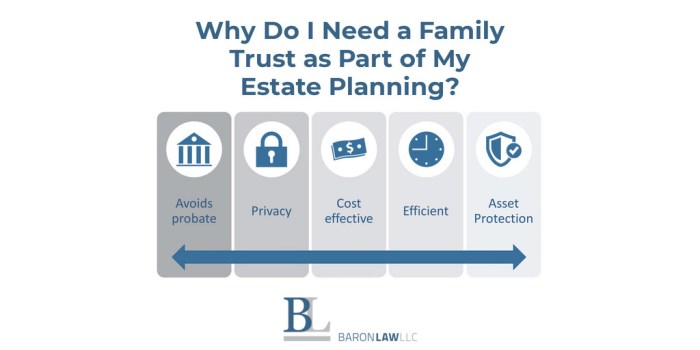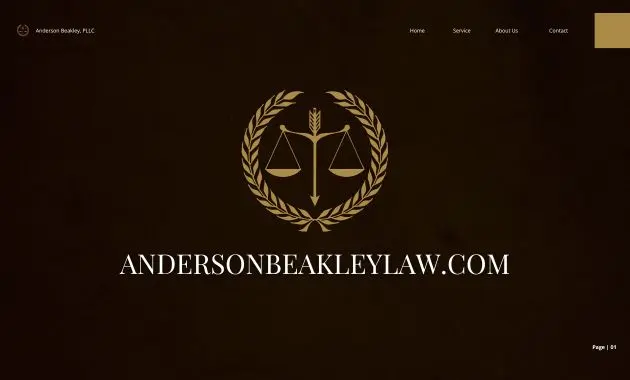Family trust planning is a powerful tool for securing your legacy, ensuring your assets are protected and distributed according to your wishes. This intricate process involves establishing a legal framework, often a trust, to manage and safeguard your wealth for present and future generations. It’s a comprehensive approach that goes beyond simply drafting a will, encompassing asset protection, estate tax minimization, and the preservation of family wealth.
This guide delves into the multifaceted world of family trust planning, exploring its benefits, complexities, and real-world applications. We’ll uncover how trusts can help families navigate various challenges, from protecting assets from creditors to facilitating wealth transfer across generations.
Estate Planning and Asset Protection
Family trust planning plays a crucial role in both estate planning and asset protection. It allows individuals to distribute their assets according to their wishes, minimizing taxes and probate fees, while safeguarding assets from creditors and lawsuits.
Also Read
Minimizing Estate Taxes and Probate Fees
Trusts can be powerful tools for minimizing estate taxes and probate fees. By transferring assets into a trust, individuals can avoid the high tax rates that often apply to large estates. This is especially beneficial for wealthy individuals who want to ensure their heirs receive the maximum benefit from their inheritance.
- Revocable Living Trusts: These trusts allow the grantor to retain control over the assets during their lifetime and distribute them according to their wishes after their death. They can be modified or revoked at any time, offering flexibility in estate planning.
- Irrevocable Trusts: Once established, these trusts cannot be modified or revoked by the grantor. They offer significant tax benefits by removing assets from the grantor’s estate for tax purposes.
Probate is the legal process of administering an estate after a person’s death. It can be costly and time-consuming, especially for large estates. Trusts can help avoid probate by transferring assets outside the probate process, saving heirs time and money.
Protecting Assets from Creditors and Lawsuits
Trusts can provide a shield against creditors and lawsuits, safeguarding assets from potential financial risks.
- Asset Protection Trusts: These trusts are specifically designed to protect assets from creditors and lawsuits. They can be used to shield assets from business debts, personal liabilities, or divorce proceedings.
- Spendthrift Trusts: These trusts prevent beneficiaries from squandering their inheritance. They limit the beneficiary’s ability to access the trust funds, ensuring that the assets are used responsibly and remain protected.
“By placing assets in a trust, individuals can protect their wealth from potential financial risks, ensuring that their loved ones inherit the intended benefits.”
Benefits for Different Family Dynamics

Family trust planning is not a one-size-fits-all solution. It’s a versatile tool that can be tailored to meet the unique needs of diverse family structures. Understanding how trusts can benefit different family dynamics is crucial for making informed decisions about wealth transfer and asset protection.
Family trust planning can encompass a wide range of considerations, including the care of aging or disabled loved ones. A crucial element in this planning process is the establishment of clear and legally sound agreements regarding caregiving responsibilities, often referred to as Family caregiver agreements. These agreements can help protect both the caregiver and the care recipient by outlining financial compensation, caregiving duties, and other essential details.
Such agreements, when incorporated into a comprehensive trust plan, can provide a strong foundation for navigating the complex needs of aging and caregiving.
Families with Minor Children
When children are minors, parents often face concerns about managing their assets and ensuring their financial security. Family trusts can play a crucial role in addressing these concerns.
- Guardianship and Management: Trusts can designate a trusted individual, such as a parent, guardian, or family member, to manage the child’s assets until they reach a specified age. This provides peace of mind, knowing that the child’s financial interests are protected.
- Protection from Creditors: Assets held in trust are generally shielded from the child’s personal debts and creditors. This protects the child’s inheritance from potential financial liabilities.
- Tax Advantages: Trusts can be structured to minimize tax burdens on the child’s inheritance. For example, a trust can distribute income to the child at a lower tax rate than they would pay individually.
Blended Families
Blended families often face unique challenges when it comes to estate planning. Trusts can help navigate these complexities and ensure fairness and clarity.
Family trust planning can help safeguard assets for future generations, but it’s crucial to consider the financial implications for the current generation. For those seeking to leverage their home equity in retirement, Reverse mortgage counseling can provide valuable insights. Understanding the potential tax and estate planning implications of such a strategy is essential when structuring a family trust.
- Protecting Spousal Rights: Trusts can be used to protect the interests of a surviving spouse while ensuring that assets are distributed according to the wishes of the deceased spouse. This can prevent disputes and ensure that the deceased’s intentions are carried out.
- Distributing Assets to Children from Previous Marriages: Trusts can be used to ensure that assets are distributed fairly among children from previous marriages and the current spouse.
Family trust planning often focuses on the distribution of assets after death, but it’s equally important to consider the possibility of incapacitation. As individuals age, the need for legal guardianship may arise, a process that can be facilitated through careful estate planning. Resources like Legal guardianship for elderly can provide valuable information on this crucial aspect of family trust planning, ensuring that loved ones are protected and their wishes are honored.
This helps avoid potential conflicts and ensures that all beneficiaries receive their rightful share.
- Avoiding Probate: Trusts can help avoid the lengthy and costly probate process, which can be particularly challenging in blended families with multiple beneficiaries.
Families with Special Needs Members
Families with members who have special needs often face concerns about providing for their long-term care and financial security. Trusts can be a valuable tool in addressing these needs.
- Preserving Eligibility for Government Benefits: Special needs trusts are designed to protect the beneficiary’s eligibility for government benefits such as Medicaid and Supplemental Security Income (SSI). These trusts allow the beneficiary to receive financial support without jeopardizing their access to essential benefits.
- Managing Finances: Trusts can provide a safe and structured way to manage the beneficiary’s finances, ensuring that their needs are met and their assets are protected.
Family trust planning is a crucial component of estate planning, ensuring the smooth transfer of assets and minimizing potential tax liabilities. A well-structured trust can also help avoid the complexities and costs associated with probate, a legal process that can be particularly burdensome for seniors. If you’re looking for guidance on navigating the intricacies of probate, resources like Probate administration for seniors can offer valuable insights.
By proactively addressing estate planning needs, families can protect their loved ones and secure their financial future.
- Ensuring Long-Term Care: Trusts can be used to provide funds for the beneficiary’s long-term care, such as housing, medical expenses, and other essential needs.
Considerations and Potential Drawbacks
While family trust planning offers numerous benefits, it’s crucial to understand the potential drawbacks and complexities involved. These considerations can impact your decision-making process and help you determine if a trust is the right approach for your family’s needs. It’s essential to seek professional legal and financial advice before establishing a trust. This guidance will ensure that the trust is structured appropriately to achieve your goals, minimize tax implications, and comply with all relevant laws and regulations.
Family trust planning can encompass a wide range of considerations, including ensuring the well-being of loved ones as they age. This might involve planning for potential needs related to elder housing and residency rights , which can be complex and vary by jurisdiction. By carefully crafting a trust, families can create a framework that addresses both financial and personal care needs for their aging members, providing peace of mind for both generations.
Legal and Financial Advice
Trusts are complex legal instruments, and navigating their intricacies requires expertise. Consulting with an experienced estate planning attorney is crucial to ensure that your trust is drafted correctly, reflecting your specific wishes and objectives. A qualified attorney can help you:
- Determine the appropriate type of trust for your circumstances.
- Draft the trust document to ensure it complies with all applicable laws and regulations.
- Identify potential tax implications and strategies to minimize them.
- Address any potential conflicts of interest among beneficiaries.
- Plan for future changes in your family dynamics.
Similarly, a financial advisor can provide insights into the financial aspects of trust planning, including:
- Asset allocation and investment strategies within the trust.
- Tax implications of trust income and distributions.
- Potential estate tax consequences.
- Financial planning for beneficiaries.
Ongoing Administrative Requirements and Costs
Once established, trusts require ongoing administrative tasks and expenses. These responsibilities include:
- Maintaining accurate records of trust assets and transactions.
- Filing tax returns for the trust.
- Distributing income and principal to beneficiaries as specified in the trust document.
- Paying for ongoing legal and accounting fees.
- Monitoring changes in laws and regulations that may affect the trust.
These administrative burdens can be significant, especially for complex trusts with substantial assets. The cost of managing a trust can vary widely depending on its complexity, size, and the level of professional assistance required.
Family trust planning is an essential part of estate planning, ensuring your assets are distributed according to your wishes. However, it’s crucial to consider the potential impact of Social Security disability law on your beneficiaries, as certain trust structures could affect their eligibility for benefits. Understanding these legal nuances can help you create a trust that effectively protects your loved ones while maximizing their potential financial security.
Steps to Create a Family Trust

Creating a family trust involves a structured process that ensures the trust’s effectiveness and legal compliance. It requires careful planning and attention to detail, encompassing various steps to establish a legally binding document that safeguards your assets and fulfills your wishes for their distribution.
Essential Documents and Information
Gathering the necessary documents and information is crucial before embarking on the trust creation process. These documents provide a comprehensive foundation for the trust’s establishment and ensure its legal validity.
- Personal Identification: This includes driver’s licenses, passports, and social security numbers for all involved parties, including the grantor, trustee, and beneficiaries.
- Financial Information: This encompasses bank statements, investment account details, real estate deeds, and any other documentation reflecting the assets that will be transferred to the trust.
- Legal Documents: This includes wills, powers of attorney, and any existing trusts that may need to be modified or integrated with the new trust.
- Beneficiary Information: This includes names, addresses, and contact details of all intended beneficiaries, along with their relationship to the grantor.
- Tax Identification Numbers: This includes the grantor’s and beneficiaries’ social security numbers or employer identification numbers (EINs), as required for tax reporting purposes.
Selecting a Trustee and Beneficiaries, Family trust planning
The selection of a trustee and beneficiaries is paramount to ensuring the trust’s successful operation and fulfillment of its objectives.
- Trustee: The trustee is responsible for managing the trust’s assets and distributing them according to the grantor’s instructions. The grantor can choose a family member, friend, or professional trustee, such as a bank or trust company. Factors to consider when selecting a trustee include their financial expertise, trustworthiness, and ability to manage the trust’s assets effectively.
- Beneficiaries: The beneficiaries are the individuals or entities who will ultimately receive the trust’s assets. The grantor can designate specific beneficiaries, such as children, grandchildren, or charities, or create a more flexible structure, allowing for beneficiaries to be added or removed as needed. It’s important to clearly define the beneficiaries and their respective shares of the trust’s assets.
Examples of Trust Structures

Family trusts offer a versatile way to manage assets and plan for the future. Understanding the different types of trusts and their characteristics is crucial for selecting the most suitable structure for your needs.
Types of Family Trusts
The following table Artikels several common types of family trusts, highlighting their key features, benefits, and potential drawbacks.
| Trust Type | Purpose | Benefits | Potential Drawbacks |
|---|---|---|---|
| Revocable Living Trust | To manage assets during your lifetime and transfer them to beneficiaries upon your death. | – Avoids probate, a lengthy and costly legal process.
|
– Assets may be subject to estate taxes.
|
| Irrevocable Living Trust | To transfer assets out of your estate for tax planning purposes. | – Can reduce estate taxes.
|
– You lose control over the assets once they are transferred to the trust.
|
| Testamentary Trust | To transfer assets to beneficiaries after your death, as Artikeld in your will. | – Provides flexibility in distributing assets to beneficiaries.
|
– Assets are subject to probate.
|
| Special Needs Trust | To provide for the financial needs of a beneficiary with disabilities without jeopardizing their eligibility for government benefits. | – Protects government benefits.
|
– Can be complex to set up and administer.
|
| Grantor Trust | To transfer assets to beneficiaries while maintaining control over the assets during your lifetime. | – Allows you to retain control over the assets.
|
– Assets may be subject to estate taxes.
|
Case Studies and Real-World Applications: Family Trust Planning
Family trust planning, while often seen as a complex legal construct, offers practical solutions for various family dynamics and goals. Real-world examples demonstrate its effectiveness in achieving financial security, preserving family wealth, and ensuring a smooth transition of assets across generations.
Business Succession Planning
Trusts can play a crucial role in facilitating a seamless transfer of ownership and management of family businesses.
- Example: A successful family-owned manufacturing company, with the founder nearing retirement, established a trust to hold the business shares. The trust agreement Artikeld the succession plan, ensuring that the company would be managed by the next generation while protecting the family’s interests. This structure prevented potential disputes among family members and provided a framework for the business’s long-term stability.
- Challenges: The key challenge in this case was ensuring that the designated successor had the necessary experience and skills to lead the company. The trust agreement addressed this by establishing a mentorship program for the next generation to gain hands-on experience under the founder’s guidance.
- Success: The trust structure successfully transitioned ownership and management, enabling the business to thrive under the new leadership. The family remained united, with clear roles and responsibilities defined within the trust agreement.
Charitable Giving
Family trusts can facilitate charitable giving by enabling families to establish philanthropic foundations or direct donations to specific causes.
- Example: A wealthy family created a charitable trust to support education initiatives in underserved communities. The trust held a significant portion of the family’s wealth, and its income was used to fund scholarships, educational programs, and infrastructure development in disadvantaged areas.
- Challenges: Managing the trust’s investments and ensuring the charitable objectives were met effectively required careful planning and oversight. The family appointed a board of trustees with expertise in philanthropy and finance to oversee the trust’s operations.
- Success: The charitable trust successfully achieved its philanthropic goals, making a tangible impact on the lives of countless individuals. The family’s legacy extended beyond their lifetime, leaving a lasting mark on society.
By thoughtfully crafting a family trust plan, you can achieve peace of mind knowing your family’s financial future is secure. This process involves careful consideration of your individual circumstances, goals, and potential challenges. Seeking expert legal and financial advice is crucial to ensure your trust is structured effectively and aligns with your specific needs. Remember, a well-designed family trust plan is a powerful legacy that can benefit your loved ones for generations to come.



